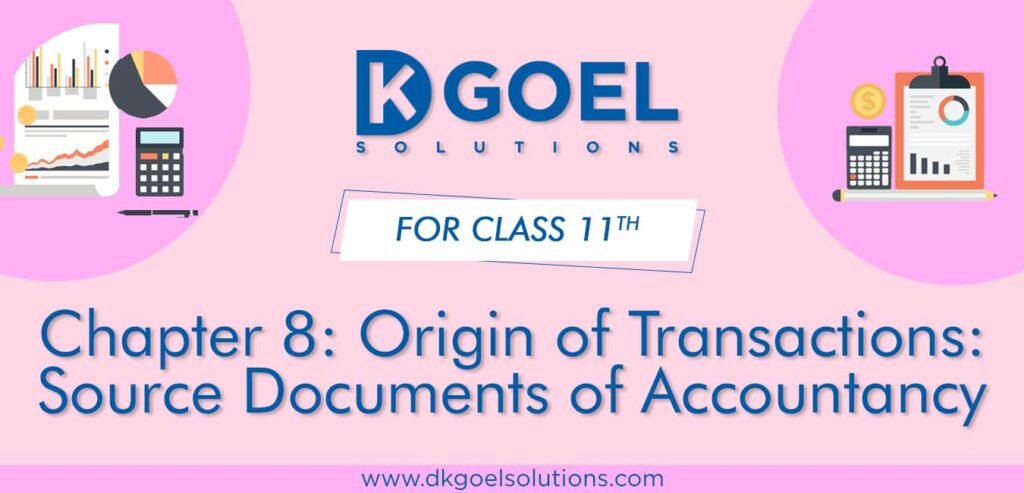DK Goel Solutions Chapter 8 Origin of Transactions Source Documents of Accountancy
Read below DK Goel Solutions Class 11 Chapter 8 Origin of Transactions Source Documents of Accountancy. These solutions have been prepared based on the latest Class 11 DK Goel Accountancy book issued for this academic year.
This chapter gives an insight into source documents of accountancy, invoice, cheque, and other processes regarding the initial phases of transactions.
The chapter also includes lot of good quality questions which are very well designed and can be very helpful to understand the concepts for Class 11 students of Accountancy.
DK Goel Solutions Class 11 Chapter 8 solutions are free and will help you to prepare for Class 11 Accountancy.
Origin of Transactions Source Documents of Accountancy DK Goel Class 11 Accountancy Solutions
Students can refer below for solutions for all questions given in your DK Goel Accountancy Textbook for Class 11 in Chapter 8
Question 1:
Solution 1: The source records are the transaction details depending on which account the balance transacted is debited or credited to. A source document is a written document which contains transaction information. In accounting, a source record is of prime importance because accounting is based on factual financial documentation that is evidence. Often referred to as supporting documentation are the source documents.
Question 2:
Solution 2: Below are the two sources of documents:-
(i) Bills and Invoice
(ii) Receipt
Question 3:
Solution 3: Invoice is a bill provided by the seller to when he sells goods on the credit basis. The bill consists of buyer’s name, name of the product to be sold, the price, quantity, and the total amount of goods sold.
Question 4:
Solution 4: A cheque is a paper form drawn to the bank to pay the person’s name written on it a determined quantity of amount.
Question 5:
Solution 5: Credit voucher is the example of voucher.
Question 6:
Solution 6: Multiple debits on one side and one credit on the other side of a transaction and multiple credits on one side and one debit on the other side of a transaction are shown in the compound voucher.
Question 7:
Solution 7: Below are the types of voucher:-
(i) Debit voucher
(ii) Credit voucher
Question 8:
Solution 8: For the depreciation paid on equipment, a swap coupon or a non-cash voucher would be prepared.
Value-Based Question of DK Goel Solutions Class 11 Chapter 8
Question 1:
Solution 1: The importance inherent in tracking transactions on the basis of source records is the confirmation of efficient and ethical transactions.
Question 2:
Solution 2: Cash memo is a source document.
Question 3:
Solution 3: Below are the values not followed by the shopkeeper are:-
(i) Requirements of low
(ii) Transparency
Question 4:
Solution 4: The few common source documents are.
Cash Memo – The Cash Memo offers cash-based purchases of products and services. You need to satisfy these criteria when designing the name, price, number, date, duration, etc. of the cash memo object.
Invoice & Bill – The Invoice & Bill offers credit-based purchases of products and services. These criteria need to be met when designing the buyer’s invoice name, date, price, quantity, etc.
Receipt – When cash or cheques are issued, receipts are given. These criteria need to be fulfilled when designing the name of the receiver, date, price, quantity, etc.
Debit Note – In case of purchase return we are prepare debit note.
Credit Note – In case of sales return we are prepare credit note.
Pay-in-slip – If we want to deposit cash and cheque into bank we need to fill pay-in-slip.
Cheque – A cheque is a paper form drawn to the bank to pay the person’s name written on it a determined quantity of amount.

Source documents are the documents that verify the authenticity of a business transaction. It is basically a written document that reflects the transactions. In accounting, a source record possess excellent importance as all the accounting is based on these documents as evidence.
Two sources of documents are as follows –
● Cash Voucher
● Bills and Invoice
An invoice is a type of bill supplied by the seller to the buyer during the purchase of any service or goods on a credit basis. The bill presents a clear picture of the transaction, highlighting the buyer’s name, the product name, the selling amount, quantity, and the number of products sold.
A Cash Memo is a type of common source document supplied to the trader during the sale of goods. The cash memo defines the name, price, quantity, date and time of sale, and other details of the goods, which help the trader enter the record in the accounting book.
Here are the four most common source documents are as follows –
Invoice & Bill – On every credit sell the trader supplies a sale invoice containing all the details of the sale. However, when the trader has hands on a good, he receives a bill mentioning the details of the purchase.
Receipt – Whenever a customer makes a purchase, the seller provides him a receipt on successful payment. Typically, the seller supplies the customer an original receipt while he keeps a duplicate for future references.
Debit Note – A debit note is issued by a customer while returning goods to the seller.
Pay-in-slip – This is a written slip deposited to a financial institution while depositing money.
A cheque is basically a written document or order used to withdraw or deposit funds. Every cheque consists of a counterfoil that records each transaction performed through cheques.
The two types of vouchers are – the credit voucher and the debit voucher.
